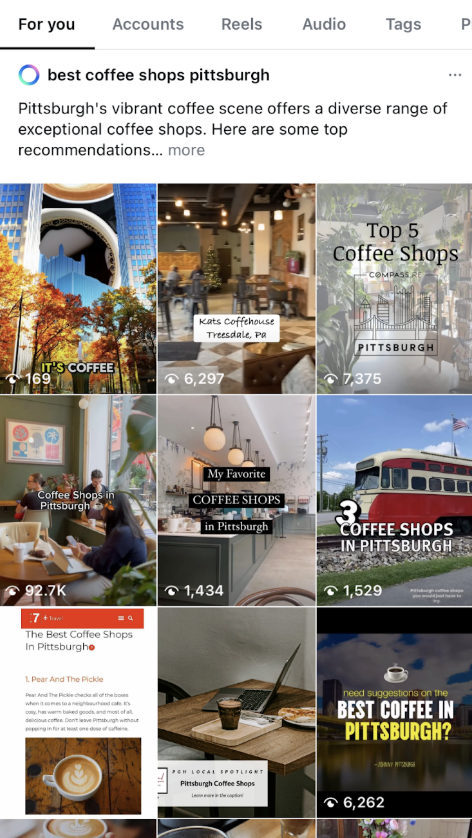Social Search Optimization for Multi-Location Brands
Summary
Discover how Social Search Optimization (SSO) helps multi-location brands rank higher in social media searches. Learn how to optimize profiles, keywords, and content on TikTok, Instagram, and YouTube to boost local visibility and attract ready-to-buy customers.
Search habits are shifting and social media is leading the change. More people, especially younger audiences, now use platforms like TikTok, Instagram, and YouTube as their go-to search engines. They’re not just scrolling for entertainment anymore; they’re searching with intent.
In SOCi’s Consumer Behavior Index, 55% of 18- to 24-year-olds said they discover new products, services, or businesses on social networks. That’s more than half of an entire generation turning to social platforms to make purchasing decisions.
TikTok’s head of North America business marketing, Rema Vasan even noted at a panel during Advertising Week New York that 86% of Gen Zers now search on TikTok instead of traditional search engines. (emarketer.)
For multi-location businesses, especially, this shift changes everything. Your social presence is no longer just about brand awareness — it’s about discoverability.
What Is Social Search Optimization?
Social Search Optimization (SSO) is the process of improving your brand’s visibility within social media search engines. Just as search engine optimization (SEO) helps you rank higher on Google, SSO ensures your content appears when people search directly on platforms like Instagram, TikTok, or YouTube.
Algorithms on these platforms analyze captions, keywords, text overlays, and engagement signals. The more optimized these elements are, the easier it becomes for users to find your brand when searching for what you offer.
Imagine searching for “best coffee shops Pittsburgh” on Instagram. The top results aren’t random. They’re posts that include the words “coffee shops” and “Pittsburgh” either in their caption or overlay on the image or video. The pages that show up are typically the ones that are active, consistent, and keyword-optimized.
For multi-location brands, this visibility drives local discovery. Each local page serves as its own mini search engine. When every page is active, keyword-optimized, and location-specific, nearby customers can easily find — and choose — your business.
How to Build a Social Search Strategy That Works
Once your team understands how social search works, the next step is building a repeatable strategy. A strong social search framework ensures every location page is optimized for visibility — from your profile setup to your engagement habits.
1. Optimize your profiles for search
Your profile is the foundation of your social search strategy. Every social page should include clear, searchable information such as your business name, location, and relevant keywords. Think of your profile bio as a mini homepage, it should tell both users and algorithms exactly who you are and where you’re located.
2. Use keywords strategically
Hashtags are no longer the key to reach they once were; instead, algorithms are prioritizing keywords in captions, text overlays, and even video subtitles. This means writing captions in natural language that reflects how people actually search.
For example, instead of “#BestCoffeePittsburgh,” think “Looking for the best coffee shops in Pittsburgh?” That conversational phrasing is what users type into search bars and is also what platforms now favor.
Focus on trending local or niche keywords (e.g., “San Diego family dentist”) and add alt text where possible.
3. Create searchable content
Content that answers questions or provides local value performs best in social search. Try:
- Short how-to videos and local guides
- FAQs that address common queries
- Collaborations with micro-influencers or creators
- User-generated posts tagged with your locations
Short-form video (Reels, Shorts, TikToks) remains the most effective format for discoverability.
4. Engage consistently
Engagement tells algorithms your content matters. Likes, comments, shares, and saves all signal relevance, but shares and saves hold the most weight. That means the more your content inspires action, the more visible it becomes.
Responding to comments and direct messages quickly, even when it’s not a customer service issue, can also strengthen engagement signals and build trust with your community.
5. Measure and refine
Just like traditional SEO, social search optimization isn’t something you set and forget. The most successful brands treat it as an ongoing process of measurement and refinement.
Work jointly across your SEO and social teams to:
- Track keyword and engagement trends
- Compare performance by location
- Replicate high-performing formats across all pages
Over time, you can identify which types of content or locations perform best in social search and replicate those insights across your entire brand footprint.
Social Search Optimization: The Bottom Line
Social search is redefining how consumers discover businesses. For multi-location brands, that means every local page is an opportunity to be found by customers who are already looking for what you offer. ptimizing profiles, using strategic keywords, creating engaging local content, and encouraging authentic interaction all contribute to stronger visibility.
With SOCi, multi-location marketers can manage and optimize all of this at scale. SOCi’s platform helps you monitor performance, streamline publishing, and ensure every location page is visible, consistent, and discoverable across today’s most influential social platforms.





